


Many parents worry about their children being bullied at school but don’t know how to help protect their children. Here we will provide tips on how to recognize bullying, empower children to confidently defend themselves without resorting to physical violence, and how to reduce the likelihood of becoming the victim of a bully in the first place.
What is Bullying?
Bullying is defined as intentional tormenting in physical, verbal, or psychological ways. It can range from hitting, shoving, name-calling, threats, and mocking, to extorting money and possessions.

It can be difficult to recognize bullying from typical childhood behavior. Children learn social skills and how to work within a group through trial and error. Often times this takes the form of teasing and excluding others. While this behavior can cause hurt feelings, if it is not done intentionally then it is not considered bullying.
The line is crossed when an activity is engaged in with the sole purpose of causing harm to another person.
Adults can help children understand what bullying is by pointing it out when they see it in movies or read about it in books. Asking questions like, “have you ever seen something like this happen?” or “what would you do if this happened to you?’ or “how would you feel if you were in this situation?” starts conversations and lets your child know that they can talk to you about bullying.

Empowering Children To Confidently Defend Themselves WITHOUT Violence
The old thinking about bullying was to encourage children to fight back. While this line of thinking might be appealing to adults, it only makes the situation worse for the victim. When a child who is being bullied fights back, it opens them up to serious school and community consequences. It could leave a child who is being bullied kicked out of school or out of an activity they really enjoy. This is in addition to the possibility of both children being physically injured.
School administrators these days often have “zero tolerance” policies regarding fighting, and it usually makes no difference “who started it!” If children are fighting and the problem persists, they are often suspended or expelled from school. If a child is expelled, then the parent will have to enroll the child in the nearest neighboring school district and driving him there daily (no matter how far or how inconvenient it may be.) The only other option is usually homeschooling or some kind of online independent study program that the parent must pay for and supervise, so the consequences of a child being expelled can be quite serious and far reaching!
So how can we empower children to confidently defend themselves without violence?
Stop, Walk and Talk

The first line of defense for a child being bullied is to tell the other child in a loud, clear and firm voice to stop. This should be a quick exchange such as, “Stop kicking me. You do not have the right to hurt me.” Immediately following that short statement the child should walk away and find an adult.
Teachers are often bombarded with post recess “tattling sessions” and might not be able to hear a child’s concerns right away. (We’ll explain more on the difference between tattling and reporting real issues below.) Teach your child the difference between a tattletale and a serious problem. Explain to your child that if they are not currently in danger, their concern can probably wait until the teacher or other adult has time to really sit and listen.
If they are in danger an adult needs to be told immediately. Teaching your child to communicate effectively with adults will help them get the help they need when they need it.
The key words that might help get a busy teacher’s attention are probably something like, “_____ is bullying me every day at recess. I have a bruise here. Could you please take a look and help me solve this problem?” Another example of what to say to a teacher might be, “John kicked me at lunch I am not hurt. I told him to stop and I walked away. I need your help to make sure it doesn’t happen again.”
Clear communication is key to empowering children to defend themselves.
Find Allies

When children are bullied they often walk away feeling ashamed and alone. To fight back against these feelings and to increase their ability to stand up to bullies in the future, children should be encouraged to find peers and adults that are supportive.
If your child comes home from school saying that they have been bullied, help them identify allies they have at school that would be able to support them. Is there someone in their class that they could play with at recess? Do they have a friend who could go with them to talk to an adult? Let your child know that they are not limited to the members of their class, older and younger children could prove to be very helpful as well. Encourage them to help other children who are being bullied as well.
Finding allies and supporting others will help your child feel less alone and more secure in their ability to stand up to bullies.
Create a Safety Zone

Help your child defend themselves against bullies by encouraging them to stay in safe zones.
This means staying close to other people and keeping in close contact with adults. Encourage them to play group games at recess, sit with others at lunch and to always know who the adult in charge is throughout the day.
Again, if your child is having difficulty connecting with peers their own age, encourage them to eat lunch with older children or play handball with younger ones. They will gain confidence in their ability to connect with other children and will feel more comfortable standing up for themselves. Sometimes teachers can help children that need friends find each other by grouping compatible children together in the classroom, and even by helping to buddy kids up before recess begins. It can be as easy as a simple phone call, email, or note to your child’s teacher!
How to Help Your Child Avoid Becoming a Victim
Research has shown that there are some factors that make a child more likely to be targeted. These include low self-esteem, poor social skills, perceived passiveness and those with physical characteristics that are different than the majority of other students. Here are three ways to bully proof a child who is at risk.
Develop Healthy Social Skills
Children who are perceived as not fitting in or annoying by their peers are at greater risk for being bullied. If you are concerned that your child may fall into this risk category help them learn how to relate to others. Find out what their passions and interests are and help them find like-minded peers in afternoon clubs, classes, or play dates. They will learn to connect with others around an interest and gain valuable confidence in their ability to make and sustain relationships.
Another way to help foster healthy social skills is to practice them at home. Role-play how to start a conversation, how to ask to join a game and what to do if they feel frustrated by another child. Practicing these skills at home in a safe environment will give them the confidence they need to use them at school.
Both children and adults that hold their heads high and look people in the eye are viewed as more confident and are less likely to become targets of bullying. So teach your child to walk confidently with his or her head high and his shoulders back. Help your child understand that the more he “looks afraid” or meek, the more likely it is that a bully will choose him as a victim, because bullies are usually pretty cowardly themselves! You may be able to point out examples of characters on television that are acting meek and others that are acting confidently with their body language.
Remember, bullies are looking for someone EASY to pick on. They don’t want to torment someone that seems likely to fight back, so adopting body language that shows self confidence is very important!
Respect Others

When children are respectful of others they are less likely to be bullied. Being respectful helps children stay connected to their peers and results in the child being less isolated.
Part of being respectful is knowing when sharing information with an adult would be telling or tattling. Helping your child understand when information needs to be shared with an adult and when it does not will go a long way in helping them build strong peer relationships and help reduce the likelihood that they will be bullied.

Check out our “Tattletale Song” from our Classroom Management CD/DVD here. It is very effective in teaching children the difference between tattling “for fun” and reporting important information that a parent or teacher needs to know.
Communicate Confidently

Bullies often single out children who they view as being weak or lacking the confidence to stand up to them. Helping your child learn how to communicate clearly and confidently will help reduce their risk of being bullied.
Teach your child to look others in the eye and speak in a clear loud voice. Have them practice using a clear, non-whiney, speaking voice at home. Take time to teach them how to ask for help from adults, tell others that their behavior is upsetting them and how to communicate their needs to others.
If a child is viewed as someone who can ask and get help when needed, they are less likely to be targeted as someone who will remain silent about being bullied.
School should be a safe place to learn and grow for everyone. Bulling is a serious issue and needs to be addressed. If you believe your child is being bullied listen empathetically to their experience and contact the school to schedule a time to discuss the issue.

————————————————————————————
















